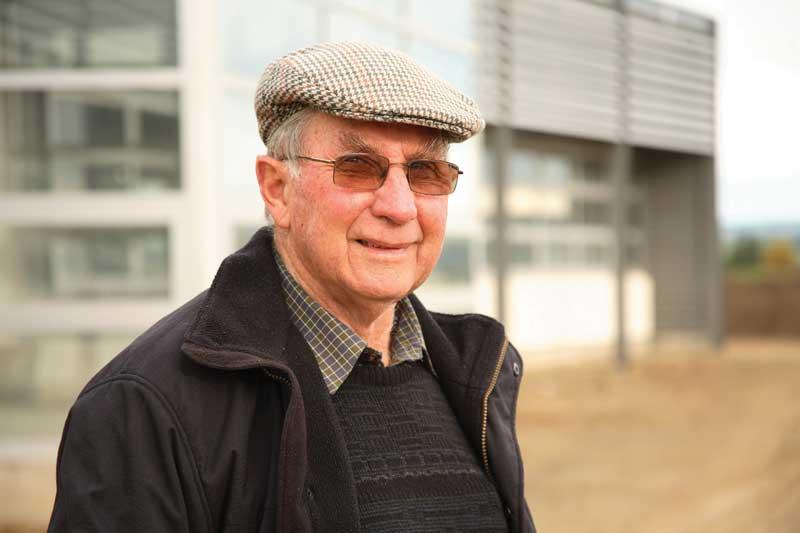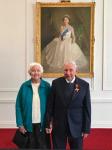Bruce Stewart

Bruce Stewart, who became an Officer of the New Zealand Order of Merit in the New Year Honours list, has a long history in roofing manufacturing.
When two young Milton builders started out on their own in 1955, they weren’t thinking much beyond the house they were building on the outskirts of their town.
But when a farmer who had ended up with a pile of railway lines from a disposal sale asked Bruce Stewart and his partner, Lance Calder, if they could help build a hayshed using the lines as uprights, they said they could.
Within a few years, one hay shed had become dozens which led to other farm work and their company, Calder Stewart, had become a large employer building woolsheds and much more across Otago and Southland.
By 1969, the company required 1200 tons of corrugated iron a year – the average house required between half to three-quarters of a ton - and Bruce Stewart and Lance Calder could see another opportunity, particularly when corrugated iron for roofing was often in such short supply that buildings couldn’t be completed.
In the mid-1960s, New Zealand Steel had opened its plant at Glenbrook, Auckland. Before then, corrugated iron had been imported from Australia and Scotland.
But NZ Steel cut its iron according to the prescribed lengths of its customer base of merchants, not individual builders.
Bruce and Lance could see huge savings if they could cut roofing iron according to the requirements of individual jobs. Costs would come down between 5 and 7.5 percent and there would be no laps when sheets of iron met, the spot where roofs tended to rust over the years. There would also be much less wastage with spouting as well.
For that, however, they needed steel coil and a corrugating machine. Ward Engineering in Christchurch could build the machine and a Dunedin merchant had excess coil capacity.
Bruce remembers that they started in roofing only to meet their own needs. But when word of what they were doing got out, they were soon approached by other builders and even local merchants.
In those days, transport was strictly regulated in favour of New Zealand Railways. Within a few years, 1000 tons was being railed to Invercargill every year. Such was demand that in 1973, the company opened a second plant with a corrugated iron roll forming machine in that city.
By that time, New Zealand Steel were sufficiently impressed by what the two men were doing that two company representatives turned up for the official opening in the southern city.
“We could cut roofing to our own lengths and that made it more efficient,” Bruce said. “And it all just grew and grew.”
Lance Calder died suddenly in 1974 but Bruce kept the business going, retaining the Calder name. Others throughout the country were undertaking similar roofing work and informal gatherings were arranged in those highly-regulated times.
“We used to have a meeting once a year in Wellington,” Bruce recalled. “There wasn’t such a thing as the NZ Metal Roofing Manufacturers’ then, it was just a group of people who had roofing machines. We had lunch in a flash hotel.”
Later, the group became more formalised and Bruce became the representative for Otago-Southland. He would attend meetings, about every two months, in Remuera where the Auckland Manufacturers’ Association was situated. By that time, a lot more people and competition were coming into the industry.
Calder Stewart itself underwent massive change with the social and economic upheaval that followed the election of the 1984-1990 Labour Government, particularly the removal of farm subsidies which had a dramatic effect on the company’s rural business.
That coincided, however, with the arrival of the first of Bruce’s four sons– Peter, Alan, Andrew and Donald –and the start of its expansion in commercial and industrial construction throughout the country which continues to this day.
The company’s roofing division has been an ongoing part of the business through good times and bad, as its products evolved from corrugated iron to highly sophisticated roofing materials and designs, ranging from houses to the complexities of the Museum of New Zealand Te Papa.
The company’s association with roofing ended this year when the division, Calder Stewart Roofing, was sold to Fletcher Building.
Bruce himself retired quietly in 2005 and was named a life member of the NZ Roofing Manufacturers Association. He can still be seen at smoko time at the company’s yards in Milton.
The Governor-General, the Rt Hon Dame Patsy Reddy, awarded him his ONZM for his services to the community and the construction industry.
An official citation acknowledged his role in business organisations including the Otago Manufacturers Association, Otago Master Builders and New Zealand Metal Roofing Manufacturers.
Bruce can look back on a lifetime of construction memories but of roofing he says: “Getting into roofing was one of the best things we did.”



